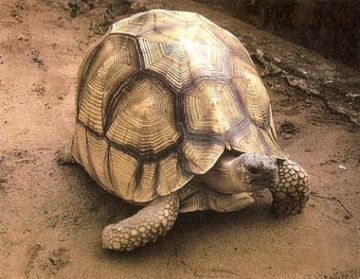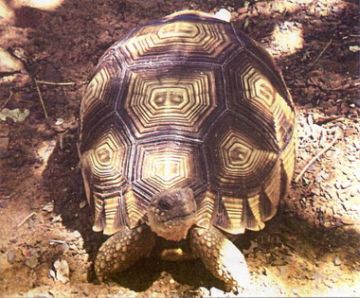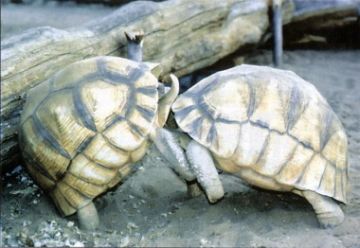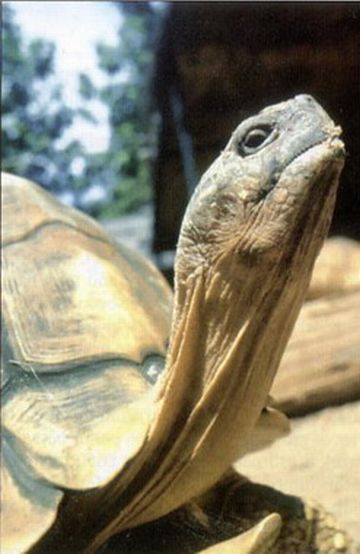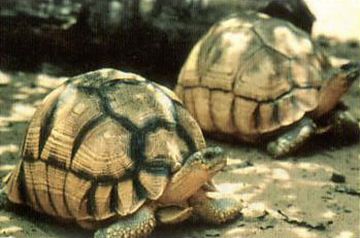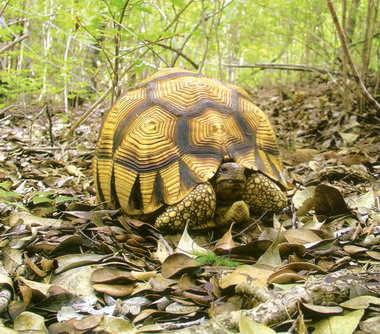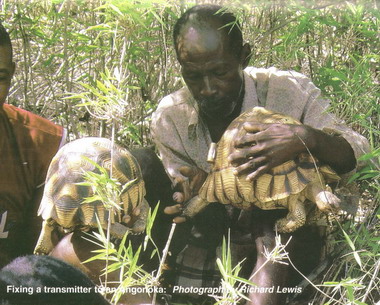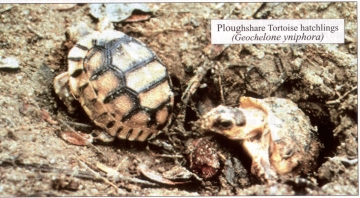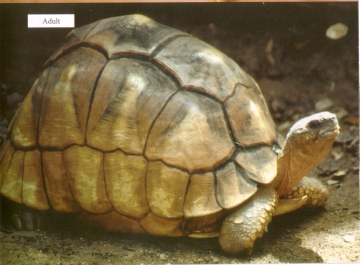It is with great pleasure and not a little excitement that I am commending to BCG members the subject of the 2006 Conservation Appeal. For it is nothing less than to invite you to contribute to a scheme purposed by the Durrell Wildlife Conservation Trust (DWCT) at Jersey Zoo to relocate some captive-bred Plougshare Tortoises (Geochelone yniphora) or Angonokas as the Malagasy call them to a specially selected area of their native habitat in Madagascar. There it is confidently expected they will thrive and form a viable population.
HISTORY OF THE PLOUGHSHARE TORTOISE CONSERVATION PROGRAMME
By the middle of the last century, the Ploughshare Tortoise (so-called because of the ploughshare shaped extension of the plastron under the animal's neck) was very nearly extinct and was classified at Critically Endangered in the IUCN Red Book. It was to be found only around Baly Bay on the west coast of Madagascar - mostly within an area of 1500 square kilometres of forest and open savannah. Fires caused sometimes by lightning and at other times by a deliberate policy of farmers seeking to create more agricultural land burned out large areas of the tortoises' habitat, killing many tortoises in the process. Only isolated small pockets of Angonokas remained; because of their growing rarity they were also under threat from collectors for the international trade in rare species. Herpetologists began to estimate the number of years it would take before this most distinctive of tortoises would become extinct.
INTERVENTION BY THE DWCT
It was at this point that the DWCT stepped in and mounted an all-out campaign to save the Ploughshares for posterity. In 1986 they launched Project Angonoka as a collaborative effort with the Malagasy Government and the support of the World Wide Fund for Nature. The BCG became involved when in 1993 I appealed for funds to help pay for the cost of the captive breeding programme in Madagascar at which time there were just 17 adults and 62 hatchlings in captivity together with a small number in the wild. I am pleased to record that we raised more than £5000 to fund one of the Angonoka enclosures at Ampijoroa. DWCT had collected the 17 adults either from the wild or had been given them after their confiscation from local gardens (it was illegal to keep them as pets or to trade in them ) and had been breeding them in captivity for about 6 years. The long-term aim was to release some captive bred Angonokas back into the wild when they were old enough as juveniles to have a reasonable chance of survival. This had never been attempted before but by dint of some very clever research and husbandry by the staff of DWCT, the scheme took off in the 1990s and achieved great success. The name of Don Reid will always be associated with this project and he was awarded the BCG Kay Gray Memorial Prize for his work with the Ploughshare Tortoises in 1994. Then in the midst of success came a terrible setback in 1999 when about half the hatchlings were stolen by a poacher during one awful night. Security measures had been in place but unfortunately they were just not good enough. However many of the stolen Angonokas have since been recovered and stricter guarding was enforced. By December 2004 there were 224 captive-bred juveniles aged about 8 or 9 and it was time to think about fulfilling the original aim of releasing some of these tortoises back into the wild.
PREPARATION FOR THE RELEASE OF THE CAPTIVE-BRED PLOUGHSHARE TORTOISES.
A. SECURITY.
First of all it is vitally important that wherever the tortoises are set free they must be safe. A start was made in 1998 when the Baly Bay area of NW Madagascar was declared by the Malagasy Government to be a National Park. In that park there is now a permanent presence of 8 full-time guards and assisting them a network of 40 village "para-rangers" who are on the Look-out for possible poachers or the start of forest fires. These guards and rangers work closely with the Malagasy police and gendarmes.
B. FEASIBILITY OF THE PROJECT.
It was also essential that a trial release should take place to ensure the feasibility of the release scheme. Accordingly in 1998 some juveniles were set free and monitored very closely in what was considered to be a suitable and safe area. This trial has been a complete success - the growth rate of these tortoises has been equal to those remaining in captivity and better than those who have always lived in the wild. There have been no deaths or injuries, no attempt at poaching and no serious fires. So the DWCT now feels confident enough to plan the release of a large number of Ploughshare Tortoises currently being cared for in captivity.
THE AIM OF THE PLOUGHSARE RELEASE PROJECT
The aims of the DWCT release project can be summarised briefly as follows:
- To increase the number of self-sustaining populations in suitable areas of Madagascar,
- To re-establish a wild, free-ranging population in an area where this tortoise has become extinct;
- To ensure that the Malagasy National Park Authority and the local community can, by being properly trained, take care of these tortoises.
To do this, some 50 to 80 Angonoka juveniles will be released over a 4-5 year period during which time their adaptation to living in the wild will be very closely monitored particularly for health, growth rates etc etc and they will carry small transmitters to accurately record their position. And by the time you read this, the releases should have already started.
THE BCG INVOLVEMENT
I am going to reserve details of the release procedure for another article in the next issue of the Newsletter. However, I want to tell you that when I visited Jersey Zoo earlier this year I was asked if the BCG would support this project as it was going to cost over £60,000 over the next 4 or 5 years. I was given thorough details of the planning. These have been considered by your Committee and a number of questions were put to the DWCT about such items as security, genetic mix of the tortoises and the overall costing. Answers from the DWCT were forthcoming at great length and the result is that the BCG is going to support two major elements of the project. Firstly, we shall pay for the 6 release and quarantine enclosures (£2,600) and for the provision of as many transmitters as we can afford to purchase with the monies raised (the maximum would be a total of 40 costing £6,800). I would like to think that we could raise the total of £9,400 necessary to meet both targets - but that will depend on your generosity.
Angonoka juveniles - Photos: Dr. Joanna Durbin, DWCT representative in Madagascar
CONCLUSION
Of all the appeals I have made over the past 15 years this is one of the most exciting I have had the pleasure of putting before you. What I am asking you to support is the culmination of a project to save the Ploughshare Tortoise from extinction - something we supported at the outset 12 years ago. To quote very roughly from a famous wartime leader - please give us the money so that we can help finish the job!
You can make a donation when you renew your membership by adding the amount you wish to donate to the form or you can send a separate donation by cheque.
Please make the cheque out to the British Chelonia Group, specifying that you want the money to go to the 2006 Conservation Appeal and send this to the:
Membership Secretary BCG,
P.O.Box 1460
Bedworth,
CV12 9ZR.
And thank you on behalf of the Angonoka Tortoises.
BOB LANGTON, CONSERVATION OFFICER (1989 - 2008).
Article from Newsletter 171
CONSERVATION CORNER: THE RELEASE OF THE ANGONOKAS
I have recently received from Richard Lewis, who is the Conservation Coordinator for the Madagascar Programme of the Durrell Wildlife Conservation Trust, a description of the transporting and release of the captive-bred Angonokas (Ploughshare Tortoises), Geochelone yniphora - from their home at Ampijoroa to their new permanent home in the forests near Baly Bay in December 2005. Since these precious tortoises are the subject of this year's Conservation Appeal, I thought our members would like to share this news:
THE RELEASE HAS BEGUN: Richard Lewis - Antananarivo - 16th December 2005
"The years of work of Durrell Wildlife that began in the 80's when the Malagasy Government invited us to develop a captive -breeding project for the Ploughshare Tortoise have reached another major milestone. The reintroduction into the wild programme began last Wednesday (the 7th) when 20 juvenile Ploughshares were transferred from Ampijoroa to their new home 200 km away (as the Madagascar teal flies) in the bamboo forest at Beaboaly, inside the Baly Bay National Park. The previous week had seen Javier Lopez, Head of FWCT Veterinary Services, working at Ampij oroa doing their final health checks. By Sunday he had finished the work and given the final OK; they were healthy to go.
Planes and cars began to move into place to get ready for the transfer. A team of us from Durrell left on the Tuesday (including Dr Mark Price, Chief Executive Officer DWCT, who was here for the release) to do the 12 hour drive to Soalala, the town by Baly Bay. That meant leaving Ampijoroa at 4am to get to Mahajanga, get the ferry across the river and then drive all day, arriving at 8pm that night. It was touch and go as a severe depression had settled around Mahajanga and the road was a nightmare of mud and floods.
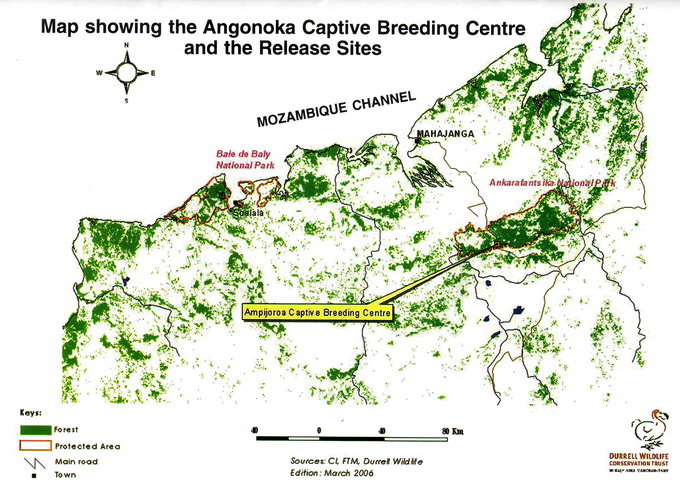
On the Wednesday morning the sun was shining brightly and all was well. Javier had been left back in Ampijoroa to travel with the tortoises by plane. We waited all day at Soalala airport for the animals to arrive. Unbeknown to us the depression was still sitting over the Mahajanga area and it made flying conditions difficult. Bob, the pilot, made one run in the morning to the park but was unable to land at Ampijoroa. But finally in mid-aftemoon he was able to leave Mahajanga and go and pick up Javier and the tortoises. They were all quickly loaded aboard the aircraft and it flew directly to Soalala. There wasn't time for chit-chat our end. We got the tortoises down to the ferry to the release site by Baly village. We got to the village at dusk to a tumultuous welcome from the whole of the village who led us to a special palm-thatched shelter decked out in greenery and flower chains. There followed an evening of speeches, dinner and finally an all-night dance (for those with stamina!). After a night sleeping on the beach, we and the tortoises finally set off for the forest. At the edge of the forest we have built a small field station. Here we and the villagers gathered. One of the elders went into a trance and spoke to us under possession as King Ndranokosoa, the last king of the region in the 19th century; he accepted our work and the efforts being made to save the tortoises. A prayer was then said to ensure the goodwill of the king and the ancestors. Then finally the 20 tortoises were brought into the forest and in groups of 5 put in the outdoor enclosures. This is where they will stay for the next month while they begin to "fix home" on the area. They will receive supplement food and water for this month; then at the beginning of January 2006 the fencing will be removed and they will begin their new life as wild tortoises. These 20 animals represent the first group of 80 Angonokas that we intend to release over the next 4 years to establish a new tortoise population in the wild.
One thing that did strike me during the two days of the release was that we only achieved it thanks to the fantastic work by all the Durrell Team, both at Tana, Ampijoroa and in the field. Also thanks to all our partners, the various Government services, the park and of course the villagers. The latter will now be one of the main managers, guardians of this new population. Their close involvement represents a major step forward in Madagascar towards the goal of empowering people to manage their resources. It also made me realise that this achievement has been built on all the people (including the British Chelonia Group) who have over 20 years helped to make this project into the success it is today. It has really been a team effort from the whole organisation to save the Ploughshare Tortoise.
27th January 2006. Last week I took our new MSc student (Henri Rakitosalama of the Zoology Dept., Antananarive University) to the release site. After a day of gluing on radios and generally checking on all the animals, we did the complete release last Sunday 22nd January. All has gone well so far. The tortoises are already moving all around Beaboaly. It's going to be a challenge to keep track of 20 animals hidden in impenetrable bamboo!
10th March 2006. I have just got back from the release site and all is going well. The 20 release tortoises are establishing home ranges and acting as they should. We have had a few glitches with the radios when the heavy rains managed to unstick some of our transmitters and radios fell off 3 animals. That meant some days crawling through the bamboo to find the animals and stick the radios back on them. We now have a system of 2 coats of glue which we hope will be enough to keep the rain out. Water gets between the radio and the shell and pushes the epoxy resin off the shell. So we have got to get a really tight seal between the epoxy and the shell. Baly Bay may be incredibly dry for most of the year, but when it rains, it pours with a vengeance!"
NOTE: The above will give an idea of the tremendous efforts that are being made to save the critically endangered Angonoka Tortoise. The BCG is proud to be associated with the DWCT in this enterprise. If you wish to help us reach our goal of raising £9400 this year for the cost of all the radios and enclosures needed over the 4 year programme, please join our 2006 appeal.
Article from Newsletter 174
2006 CONSERVATION APPEAL
Good News! As at the beginning of November, the B.C.G. Appeal on behalf of the cost of relocating the captive-bred Angonokas to their new home in Madagascar had reached the magnificent figure of £8382. Thank you for all your donations both large and small. In 2007 I will give you an update on how these precious tortoises are faring in their new home.
Article from Newsletter 184
REINTRODUCTION OF THE PLOUGHSHARE TORTOISE PROGRESS REPORT 2007-08
This project is a continuation of a 4 year effort to reintroduce the Ploughshare Tortoise (Geochelone yniphora) into the Beaboaly area of the Baly Bay National Park in north-western Madagascar where the species used to occur historically but was extirpated due to unsustainable levels of illegal collection. The overall goal of the project is to establish a new self sustaining population of tortoises, thereby reducing the threat of extinction to the species. To achieve this goal it is planned to create founder groups of around 50 individual tortoises, preferably biased towards females, from a captive population currently managed in Durrell Wildlife Conservation Trust's captive facility at Ampijoroa in Ankarafantsika National Park.
To date a trial release of five individuals and two subsequent releases of 20 animals each have been carried out. A translocation of a further 20 tortoises was scheduled for the end of 2007. However, laboratory analysis of samples taken from the last 20 animals released in January 2007 suggested that two of these animals might have been infected by the Herpes virus. Although the results of this analysis were not conclusive contaminated samples and/or false positives are a possibility we nonetheless decided to bring all the 20 animals back into quarantine pending further tests. Due to unforeseen delays caused by new permit requirements and logistical problems associated with exporting the samples to Europe for analysis, we have not yet managed to finalize this work nor the veterinary screening needed to ensure that the next batch of tortoises to be released is free of dangerous pathogens. This means that the next stage of the release has been postponed to end of 2008.
The Durrell research team has continued collecting data on the released animals and comparing these with the wild population. The results show that all released animals appear to be adapting well to the release. Their diet is similar to that of wild animals and they are putting on weight normally. No animal has shown signs of "homing" behaviour (i.e. trying to get back to its site of origin), despite initial fears to the contrary. Masters level thesis of two Malagasy students, looking at the veterinary and habitat requirement aspects of the release respectively, have now been finalized and will be defended during the course of 2008. Results will be published shortly thereafter, hopefully in a peer reviewed journal, and widely disseminated.
The tortoise release and monitoring combined with Durrell's community conservation work in the area has fostered a close working relationship with the local villagers and the Baly Bay Park Authority ANGAP Since this work began there has been a great increase in awareness and a new sense of pride is evident in the local population regarding the presence of this unique species. In October 2007 a special environmental festival "festival angonoka" was organised at the initiative of the Chief of Soalala. Using the tortoise as its symbol, this festival consisted of traditional dancing, environmental debates and displays of local grass roots organisations. It was well attended by the villagers, NGO partners and local level government authorities. Considered a great success this festival will henceforth be held annually and provides a useful platform for disseminating environmental conservation messages to the local population.
As a result of these activities the profile of Baly Bay as an important biodiversity site has been greatly enhanced. Tourists are also beginning to take notice of the potential of this area. In 2007 two groups of tourists visited the park and Durrell's tortoise research camp at Beaboaly. In March 2008 a cruise ship docked at Baly Bay for a guided tour of Durrell's activities on the ground. We are hopeful that this heightened interest in the site will lead to long term development of ecotourism and bring badly needed revenue to the local villagers that share the same habitat with the threatened tortoises.
Although there have been no reports of illegal collecting of tortoises from the Beaboaly, illegal trade in Ploughshare Tortoises does continue in the wider Baly Bay area. In an effort to try and reduce this threat Durrell has worked closely with the law enforcement authorities. A key development has been the empowerment of village vigilance committees that are allowed to search suspected traffickers. A local informer network has also been put in place that has led to many recent high profile arrests both in the capital Antananarivo and in the field. These activities, combined with the strategies put in place at the May 2007 workshop in Mahajanga, (e.g. better monitoring of movements of people in and out of the area through registration at village level and more frequent police checks at key entry and exit points) increase the level of deterrent to illegal tortoise trade.
International efforts are also underway to address the issue of illegal trade. Durrell has been exchanging information with TRAFFIC, the international programme that monitors illegal wildlife trade, to get a better understanding of illegal trade routes from Madagascar. The international spotlight also focused on the issue during a workshop on Madagascar chelonians which took place in January 2008 and which Durrell co organized. This workshop is also expected to result in a revision of the Red List assessment of the Ploughshare and other Madagascan tortoise and freshwater turtle species.
KEY ACCOMPLISHMENTS
- We have maintained continued monitoring of the release population to evaluate the success of the reintroduction. To date all animals seem to be adapting well to their new habitats.
- One of the original 5 animals released during the 1998 pilot study and presumed lost was relocated in November 2007 and is in good health
- Habitat of the release population has been effectively protected. Durrell's presence at the site, together with extensive community work, has helped to curb fires or other habitat destruction. Strong engagement of the community at Baly to the reintroduction efforts continues.
- No animals have been illegally collected from the Beaboaly since Durrell's intervention began. Several arrests of illegal collectors of Ploughshare Tortoises from other parts of Baly Bay have been made however. Strategies to stem this illegal collection have been put in place with the local villagers themselves playing a key role in the efforts.
- Awareness has been raised about the Ploughshare Tortoise and its conservation throughout the Baly Bay area and internationally. This is helping with community conservation efforts and is bringing ecotourism into the area.
- Capacity built two Masters theses by Malagasy students have been completed and are awaiting defense at the University of Antananarivo. Durrell has also continued to contribute to capacity building of the local conservation authorities (park authority ANGAP and the environment ministry) by helping develop tortoise survey techniques and community conservation actions.
- The captive population remains stable and continues to be looked after by Durrell's captive breeding programme at Ampijoroa. Reproductive activities have been observed and new births are expected.
LONG TERM SUCCESS OF YOUR PROJECT
The establishment of a Ploughshare Tortoise population in Beaboaly is largely dependent on the close collaboration with the local villagers, especially the village of Baly. The main threats to this tortoise population include habitat destruction, especially fire and illegal collecting. Given the process under way of giving the local communities more rights over the management of their natural resources, it is therefore critical that Durrell work very closely with the local people. In order to maintain the good relationships with these communities, it is essential that we continue the long term work of raising awareness among the local people of the importance of the tortoise. At the same time finding ways to help contribute to livelihoods through activities that do not impact negatively on the tortoises or their habitats should continue. To date Durrell has been successful in attracting funding from the Jersey Overseas Aid commission which is used to provide small scale development assistance. We are pleased to note that his support will continue in 2008 as it has been a cornerstone in our efforts to help maintain our relationship with the villagers. In the longer term it is hoped that the increasing interest shown by tourists in this area will bring increasing revenue to the area in the form of direct cash receipts from park entry fees and indirectly through employment of villagers in the tourism industry and related spin offs such as souvenirs made of locally woven raphia.
Although the community conservation work forms the basis for ensuring that the tortoises are protected in situ more action is needed to stem the international demand by pet collectors for this species. In this respect the continued engagement of the Malagasy authorities and increased collaboration with TRAFFIC, Interpol and other relevant parties should be encouraged and strengthened.
As the Parks overall management area it is vital that ANGAP remains engaged and committed to Baly Bay and its endemic tortoise. This requires resources both human and financial which the international community will hopefully continue to contribute.
PARTNERSHIPS
- The Ministry of Environment, Water & Forests and Tourism is responsible for all aspects of conservation and management of biodiversity in Madagascar. Durrell has established a very close relationship with the ministry at all levels and has been working particularly closely with the officials in the district and regional headquarters of Soalala and Mahajanga in keeping the ministry informed of conservation activities and in developing community conservation strategies and joint operations to combat illegal trade.
- Association Nationale Pour la Gestion des Aires Protegees (ANGAP) is mandated by the state to manage Madagascar's protected areas. As the managers of the Baly Bay National Park Durrell collaborates closely with ANGAP on all aspects of planning and implementation of conservation action inside the National Park.
- Peace Corps is an independent United States Federal Agency established to "promote world peace and friendship." In Madagascar Peace corps volunteers teach English, conduct various health and education activities, work in natural resource management and implement community development projects. Specific environmental conservation objectives include reducing degradation of the natural resource base and developing local capacity. Peace Corps currently has two volunteers stationed in Baly Bay. They provide support by promoting environmentally sustainable resource use, environmental education and ecotourism development.
This work would not have been possible with the generous support of the following funders:
- British Chelonia Group
- The members and loyal supporters of Durrell
- The Disney Wildlife Conservation Fund
- Harcroft Foundation
- Liz Claiboe Art Ortenberg Foundation
- Jersey Oversea Aid Commission.
(Article received via BOB LANGTON, Conservation Consultant)
Top

